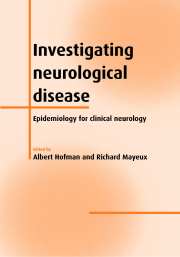
- Cited by 3
-
Cited byCrossref Citations
This Book has been cited by the following publications. This list is generated based on data provided by Crossref.
Kasten, Meike Chade, Anabel and Tanner, Caroline 2007. Clinical Diagnosis and Management of Dystonia. p. 15.
Donnet, Anne Becker, Henri Allaf, Bashar and Lantéri‐Minet, Michel 2010. Migraine and Migraines of Specialists: Perceptions and Management. Headache: The Journal of Head and Face Pain, Vol. 50, Issue. 7, p. 1115.
Gordon, Paul H. Mehal, Jason M. Holman, Robert C. Rowland, Andrew S. and Cheek, James E. 2012. Parkinson's disease among American Indians and Alaska natives: A nationwide prevalence study. Movement Disorders, Vol. 27, Issue. 11, p. 1456.
- Publisher:
- Cambridge University Press
- Online publication date:
- September 2009
- Print publication year:
- 2001
- Online ISBN:
- 9780511526909


